Lights, Camera, Action! Mastering the Art of Staging Photography
Lights, camera, action—three words that can transform an ordinary property listing into a showstopper. In this blog post, we’ll unveil the secrets of staging photography, from pro lighting techniques to the emotional “wow” factor that captures buyers’ hearts. Get ready to stage, shoot, and sell faster than ever before!
Introduction
When selling a property, it's not just the bricks and mortar you're showcasing; it's the possibility of a new beginning, a space that potential buyers can call home.
Staging photography does just that, breathing life into rooms and framing them not as empty spaces but as vibrant canvases awaiting new stories.
This is where professional polish meets personal touch, crafting each shot to show off a property's best angles and resonate with buyers on a deeper level.
Think of it as setting the stage for future memories and experiences unfolding within those walls.
It's about making an impactful first visual impression that lingers, creating a welcoming digital handshake that beckons viewers to step into a world of possibility.


The Brilliance of Home Staging Photography
Staging photography transcends simple property images.
It's a delicate blend of showcasing the functionality of a space while also conveying a warm, aspirational lifestyle.
Here are some key elements that define the brilliance of home staging photography, transforming everyday spaces into captivating scenes that draw potential buyers in:
-
Strategic Decoration: Carefully chosen furniture and decor enhance each room's features, making spaces look functional and inviting.
-
Emotional Connection: The setup is designed to evoke feelings of home, encouraging potential buyers to envision their lives in these spaces.
-
Optimal Lighting: Proper use of lighting highlights the best aspects of each room, ensuring spaces are warm and welcoming. This might involve balancing natural light with artificial sources to create the perfect ambiance.
-
Perspective and Angles: Photographers use various angles and perspectives to maximize each area's perceived size and potential, making rooms appear larger and layouts more coherent.
-
Detail Focus: Attention to detail is critical, with close-ups of unique features like custom countertops or artisan fixtures emphasizing the luxury or quality of the home.
-
Visual Storytelling: The arrangement of scenes within the home tells a story, guiding potential buyers through a visual journey that cultivates interest and desire.


Key Tips for Home Staging Photography
To truly excel in home staging photography and ensure your property stands out in the competitive real estate market, here are some crucial tips to follow:
-
Maximize Natural Light: Always try to schedule photo shoots during the brightest times of the day. Natural light brightens the space and creates an airy, welcoming atmosphere. Open curtains and blinds to let in as much light as possible, and consider timing your shoot for when the light in each room is at its best.
-
Supplement with Artificial Lighting: Natural light is ideal but not always sufficient. Use additional lighting to eliminate shadows in darker corners. Soft white bulbs can add warmth and a welcoming glow to any space.
-
Declutter and Depersonalize: Before snapping photos, remove personal items and clutter. This helps potential buyers imagine themselves in the home without distractions. Keep the decor neutral and appealing to a wide audience.
-
Focus on Composition: Pay attention to the composition of each shot. Use the rule of thirds to create interest and balance in your photos. Ensure that the furnishings are arranged in a way that highlights the space and functionality of each room.
-
Highlight Unique Features: Every home has unique selling points, whether it's a grand fireplace, a gourmet kitchen, or an elegant staircase. Make sure these features are prominently displayed and well-lit in your photos.
-
Consistency is Key: Maintain a consistent look and feel across all your photos. This creates a cohesive visual story for your listing and helps buyers navigate the images smoothly.
YOU MAY ALSO LIKE:
- How to Take Real Estate Photos with an iPhone
- MLS Advantage: Harnessing the Power of Multiple Listing Services in Real Estate
- Staging on a Budget - Tips and Tricks for DIY Home Stagers


Ready to Transform Your Space? Explore Our Staging Solutions Today!
Staging photography is an essential part of the real estate puzzle, presenting a lifestyle to potential buyers and inviting them into a space where their future can unfold.
It's the marriage of technical photography skills with the nuanced flair of interior staging, resulting in images that don't just illustrate a home but truly showcase a property in its best light.
Professional services can be invaluable if you're not seasoned in staging and photography.
At Bella Staging, we bring expertise and vision to your real estate listings, ensuring each staged photograph is a masterpiece.
We invite you to view our portfolio and see the transformative power of our virtual staging solutions.
Whether you’re a real estate agent, a property developer, or a marketing professional in the construction industry, an investment in staging photography could be the catalyst for your next standout listing. Contact us today!




